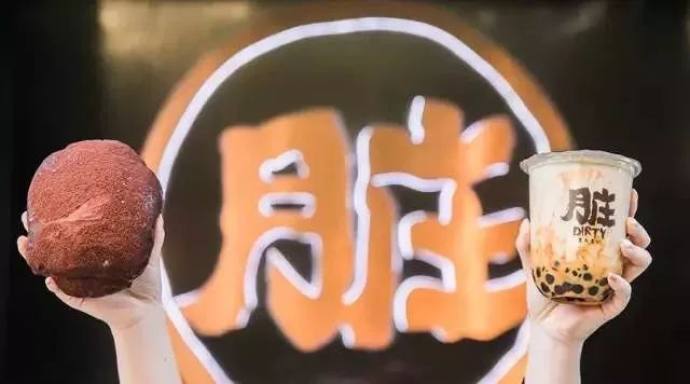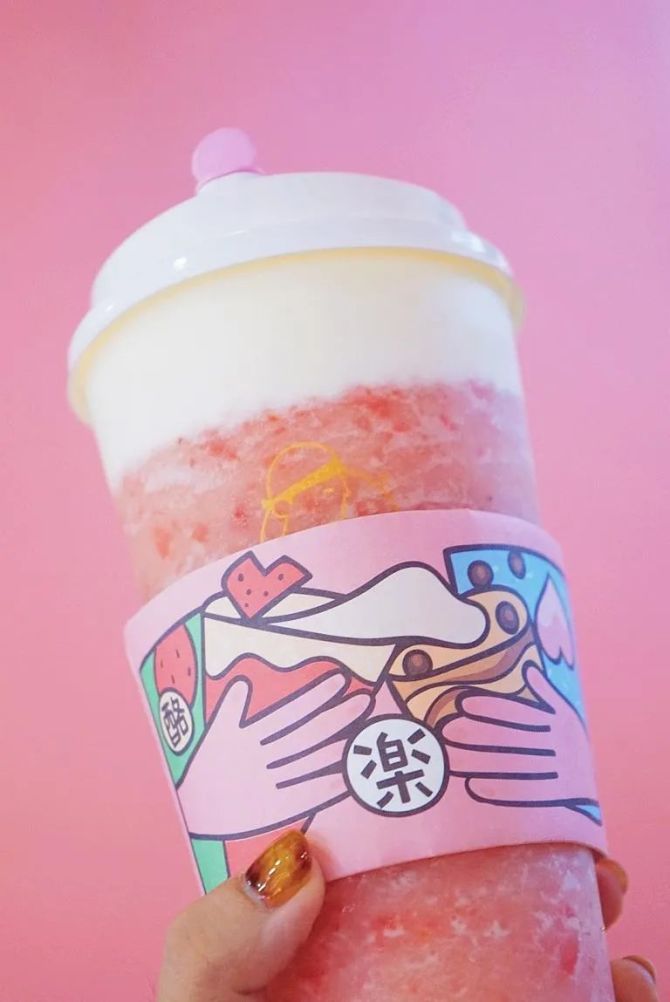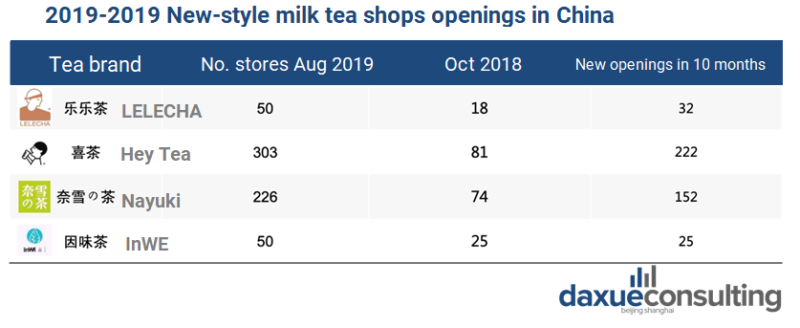In 2017, the new-style “milk tea” exploded out of the blue into China’s tea market. In Shanghai, many internet-famous (wang hong 网红) milk tea brands, such as Hey Tea (喜茶) and LELECHA (乐乐茶), have become a big hit. The new LELECHA opening in Xintiandi (新天地) went viral on social media. The lineup was no less than the crowds of Hey Tea, which Zhang Kun, the operations manager says they “never intentionally hyped ourselves as publicity stunts”
By 2020, LELECHA has opened more than 100 stores. How does LELECHA manage to keep consumers craze through only two “dirty” products: “dirty tea” and “dirty bread”? It is mainly affected by the following three factors.

Source: chuangyejia, Dirty tea+ Dirty bread
Three elements that make LELECHA a sensation
A new sales model of drink + dessert
Many Chinese milk tea shops only have drinks as their one and only product. However, for most people, a perfect combo of afternoon tea is a drink with dessert. LELECHA has noticed this market trend. The Chinese tea brand was the first to carry out the sales model to have drink and bread as the 2 categories of products and actively promote them as a “dirty combo”.
The innovative brand image of product packaging
The main target consumers of LELECHA are young and trendy people with strong consumption ability. The packaging is also very trendy from the prevailing vintage Hong Kong-style brand posters, to vintage kraft paper bags, and even cartoon images. The uniqueness of the interior design captures the current trends of nature and simplicity.
Such a unique packaging provokes people to share on their social platforms especially WeChat Moments. Hence, the brand easily achieves forward communication and increase brand exposure.

Source: smzdm, LELECHA packaging
The unique taste of a healthy drink
In fact, no matter how good-looking the package is, how innovative the sales model is, these are not the keys to customer retention.
What can truly be passed on from word of mouth is the taste. LELECHA has a professional product research and development team, which analyzes beverage products, desserts and bread products on the market, conducts research on the taste preferences of potential customers, and finally develops the tastes most favored by target consumers. The healthy materials, unique and memorable taste are the key to its popularity.
Currently, LELECHA has more than 100 branches concentratedly locate in the first- and second-tier cities in China such as Beijing, Shanghai, Guangzhou, Hangzhou and Chongqing. The economic development of these areas is relatively higher than others, there are many young people and strong consumption.
LELECHA’s mission and perseverance
LELECHA’s Mission: to advocate the lifestyle of “a bite of bread with a sip of fruit tea”
The popularity of milk tea brands in China continues to rise. With the prosperity of Hey Tea, 4,000 cups of drinks are sold a day. In its highest record, it takes 7 hours to wait in line to purchase from Hey Tea. In comparison, LELECHA, which sells 2,000 cups of drinks a day, is only 1/2 of the sales ratio of Hey Tea. However, LELECHA provides dessert breads with the beverage and the price of a combo is around 50-60 Chinese Yuan. The combination not only provides customers with more choices but also increases the unit price for the revenue.
More importantly, LELECHA has been cultivating customers‘ consumption habits of “a bite of bread with a sip of fruit tea” since its opening and making it a lifestyle. The fruit teas alternately use low-fat cheeses and selected high-quality teas. The flavors are updated according to the season. The strawberry tea with cheese foam on top is the best-seller in spring, and fresh watermelon tea with cheese foam on top is providing during summer.
Perseverance: A brand that has “temperature”
We can see that the bread + tea model is not uncommon in the market nowadays. The reason why LELECHA stands out is because of the “temperature” of the brand.
Compared with other shops which display many bread options, LELECHA only has 3-5 kind of bread on the rack; sometimes it’s even completely empty.
This is a result of LELECHA’s high requirements for baking. Its core advantage is on-site baking to ensure that the breads that customers get are warm and fresh. Thus, the amount of bread is limited every day, freshly baked bread always put on the racks only when the last baked breads are almost sold out. Another reason is that they simply do not provide a wide variety of bread.
“During the preparation, we tried to make nearly 100 kinds of bread, and then tried them one by one, we finally decided on about 15 products to sell. The main items include chocolate flavored dirty bread, durian, dragon fruit, cream cheese chocolate, spinach chicken flavor, etc.”
Zhang Kun, Operations Manager of LELECHA
Now these flavors are almost the must-order products that customers purchase every time they come to the store.
In addition to the “temperature” food, the environment of LELECHA is also a very warm space. The founder invited an Italian designer to design the stores’ interior. It’s mainly natural colors with a very special polyhedron design on the ceiling, and the dotted lights create the feeling of a starry sky. The tables and chairs are wooden, the green plants and wooden furniture make a very cozy atmosphere. LELECHA hopes that its store can become a space for consumers to communicate and express emotions.
“LELECHA hopes to create a healthy and fashionable life concept in all aspects, whether it is from healthy and delicious product design, to minimalist shop decoration, and post-marketing planning.”
Zhang Kun, Operations Manager of LELECHA


Source: 17qq, LELECHA interior
In 2019, LELECHA also began to experiment with digitization and developed its own mini-app delivery service. On social media, the biggest difference from Hey Tea and Nayuki (奈雪の茶) is that LELECHA has created a unique comic feature-LECHA JUN (乐茶君). The image of LECHA JUN appears in various official social accounts of LELECHA, which not only enhances the brand effect but also delivers positive energy of optimism, cheerfulness and lovely life to consumers. Strive to build the brand as a label that represents a new lifestyle.

Source: ChinaNationalBrand, LECHAJUN
What is the future market trend of China’s milk tea industry?
Although the number of existing milk tea shops has exploded, the homogeneity is a serious problem in the industry and the low thresholds lead to fierce competition. According to the data from Meituan Research Institute, from 2017 to 2018, The closing rate of milk tea shops in first-tier cities is as high as 55%, in second-tier cities is 35%.
However, compared with the analysis of the opening of milk tea brands in China from 2017-2019, new-style brands have a solid position in the industry as a high-end. It is foreseeable that in the future that current milk tea brands in China will focus more on high-class consumers.

Source: FORWARD, Numbers of shops from 2018-2019, daxue consulting translation
In order to improve profitability in China’s new-style tea industry, products must show more innovation, and multi-category integration. has developed into the operating direction of new-style tea brands in China. For example, Nayuki and LELECHA took the form of “drink + dessert” model, Hey Tea launched coffee products in March 2019, add cheese foam to traditional black coffee and tapioca boba, to create multiple taste for consumers. Enrich the SKU (stock keeping unit) to create products diversification and merge categories will be the development trend of China’s milk tea industry in the future.
Author: Shannon Yeh
See our full report on the tea market in China
Listen to over 100 China entrepreneur stories on China Paradigms, the China business podcast
Listen to China Paradigm on Apple Podcast





